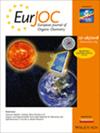Acceptor‐Donor‐Acceptor Systems Based on Indacenodithiophene‐Extended Tetrathiafulvalene
IF 2.5
3区 化学
Q2 CHEMISTRY, ORGANIC
引用次数: 0
Abstract
Here, we present a series of acceptor‐donor‐acceptor (A‐D‐A) conjugated molecules incorporating an indacenodithiophene‐extended tetrathiafulvalene (IDT‐TTF) as the central electron‐donating moiety, functionalized with various lateral electron acceptors. A key synthetic step was the Vilsmeier‐Haack formylation of the IDT‐TTF, providing the dialdehyde in quantitative yield. This compound was further used for the incorporation of dicyanovinyl and indanedione acceptors. UV‐vis absorption spectroscopy of the A‐D‐A compounds in solution revealed a broad absorption in the visible spectrum which is further red‐shifted when proceeding from solutions to thin films. Their cyclic voltammograms in solution showed a multi‐redox behavior – undergoing both oxidation and reduction events. Notably, the oxidation of these compounds unveiled the formation of intermolecular mixed‐valence and π‐dimer species, especially strong in the case of the indanedione‐containing derivative. Computational calculations helped us to identify the electronic transitions involved in the main absorption bands of these A‐D‐A compounds displaying different behaviors depending on the acceptor attached to the IDT‐TTF core. Finally, the potential of these compounds as donors in organic solar cells was investigated and the best performing solar cell exhibited a modest yet promising power conversion efficiency of 0.87%.求助全文
约1分钟内获得全文
求助全文
来源期刊
CiteScore
5.40
自引率
3.60%
发文量
752
审稿时长
1 months
期刊介绍:
The European Journal of Organic Chemistry (2019 ISI Impact Factor 2.889) publishes Full Papers, Communications, and Minireviews from the entire spectrum of synthetic organic, bioorganic and physical-organic chemistry. It is published on behalf of Chemistry Europe, an association of 16 European chemical societies.
The following journals have been merged to form two leading journals, the European Journal of Organic Chemistry and the European Journal of Inorganic Chemistry:
Liebigs Annalen
Bulletin des Sociétés Chimiques Belges
Bulletin de la Société Chimique de France
Gazzetta Chimica Italiana
Recueil des Travaux Chimiques des Pays-Bas
Anales de Química
Chimika Chronika
Revista Portuguesa de Química
ACH—Models in Chemistry
Polish Journal of Chemistry.

 求助内容:
求助内容: 应助结果提醒方式:
应助结果提醒方式:


